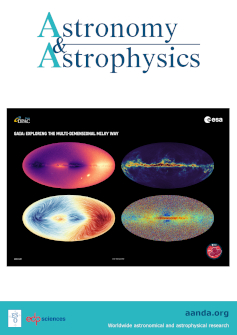银河 H II 区域扩展发射的多波长研究
IF 5.4
2区 物理与天体物理
Q1 ASTRONOMY & ASTROPHYSICS
引用次数: 0
摘要
背景H II 区域是银河系中大质量(M ≥ 8 M⊙)恒星形成地点的标志。据观测,从 H II 区域的射电连续波发射推断出的电离光子率(约 90%)明显低于从红外天文卫星测量的远红外通量推断出的电离光子率。电离光子率的这种差异可能是由于 H II 区域内存在大量尘埃,或者存在高分辨率射电干涉测量观测未能探测到的扩展发射。在这里,我们研究了八个具有延伸发射的紧凑和超紧凑 H II 区域样本,以探索其在解决差异中的作用。我们利用升级后的巨型移波射电望远镜(1.25-1.45 GHz)的观测数据和 GLOSTAR 勘测(4-8 GHz)的数据,从射电连续发射中估算电离光子率。我们还通过对来自 Spitzer-GLIMPSE、MIPSGAL 和 Hi-GAL 勘测的红外数据进行光谱能量分布函数拟合,估算出了来自红外发光度的电离光子率。射电观测对扩展辐射的灵敏度极高,使我们能够研究紧凑和超紧凑 H II 区域中被尘埃吸收的电离光子的实际比例。除了一个源之外,我们发现来自 H II 区域紧凑部分和弥漫部分的射电连续发射之间存在直接联系。我们的研究表明,如果将扩展辐射包括在内,利用射电和红外数据估算出的电离光子率是合理一致的(5-28%)。我们还在所有星源中发现了多颗候选电离星,而且无线电观测数据和候选星的电离光子率也基本吻合。本文章由计算机程序翻译,如有差异,请以英文原文为准。
A multi-wavelength study of Galactic H II regions with extended emission
Context. H II regions are the signposts of massive (M ≥ 8 M⊙) star-forming sites in our Galaxy. It has been observed that the ionizing photon rate inferred from the radio continuum emission of H II regions is significantly lower (~90%) than that inferred from far-infrared fluxes measured by the Infrared Astronomical Satellite.Aims. This discrepancy in the ionizing photon rates may arise due to there being significant amounts of dust within the H II regions or the presence of extended emission that is undetected by high-resolution radio interferometric observations. Here, we study a sample of eight compact and ultracompact H II regions with extended emission to explore its role in resolving the discrepancy.Methods. We have used observations at the upgraded Giant Metrewave Radio Telescope (1.25–1.45 GHz) and data from the GLOSTAR survey (4–8 GHz) to estimate the ionizing photon rate from the radio continuum emission. We have also estimated the ionizing photon rate from the infrared luminosity by fitting a spectral energy distribution function to the infrared data from the Spitzer-GLIMPSE, MIPSGAL, and Hi-GAL surveys. The excellent sensitivity of the radio observations to extended emission allows us to investigate the actual fraction of ionizing photons that are absorbed by dust in compact and ultracompact H II regions.Results. Barring one source, we find a direct association between the radio continuum emission from the compact and diffuse components of the H II region. Our study shows that the ionizing photon rates estimated using the radio and infrared data are within reasonable agreement (5–28%) if we include the extended emission. We also find multiple candidate ionizing stars in all our sources, and the ionizing photon rates from the radio observations and candidate stars are in reasonable agreement.
求助全文
通过发布文献求助,成功后即可免费获取论文全文。
去求助
来源期刊

Astronomy & Astrophysics
地学天文-天文与天体物理
CiteScore
10.20
自引率
27.70%
发文量
2105
审稿时长
1-2 weeks
期刊介绍:
Astronomy & Astrophysics is an international Journal that publishes papers on all aspects of astronomy and astrophysics (theoretical, observational, and instrumental) independently of the techniques used to obtain the results.
 求助内容:
求助内容: 应助结果提醒方式:
应助结果提醒方式:


